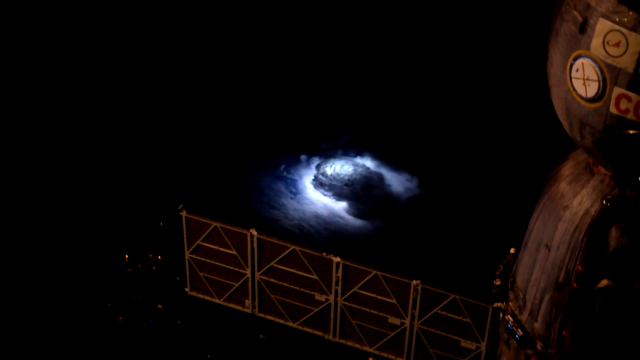At 8:01 p.m. on October 10, 2018, a bolt of lightning flashed inside of a storm cloud just east of the Indonesian island of Sulawesi. The International Space Station was passing overhead at the time, and a suite of instruments observed as the bolt produced a flash of gamma radiation—and, simultaneously, emitted a glowing ring of ultraviolet and visible light in the topmost layer of the atmosphere.
Scientists today are presenting the results of this observation, the first to capture both a terrestrial gamma ray flash, or TGF, and the visible-light component of an Elve, a dim disk of ionospheric radiation. This observation provides more evidence for the connection between lightning, the radiation produced by storms, and electromagnetic phenomena at the top of the atmosphere, while illustrating more of the wild radioactive curiosities that weather can generate.
“With our storms here, down in the troposphere, we are actually knocking at the door to space,” Torsten Neubert, the study’s first author from the Technical University of Denmark, told Gizmodo. In other words, storms in the lowest region of the atmosphere are producing effects 100 kilometers up, at the boundary between Earth and space.
The strong electric fields inside thunderstorms have the ability to accelerate particles, much like the particle colliders used by physicists. These accelerated particles can emit a flash of high-energy light called gamma rays through a runaway chain reaction inside the cloud, resulting in the TGF.
Meanwhile, Elves (short for “Emission of Light and Very Low Frequency perturbations due to Electromagnetic Pulse Sources”) are common but hard-to-see events that illuminate areas a few hundred miles in diameter at the edge of space. Elves are produced by high-amplitude electromagnetic pulses that travel all the way up to the ionosphere and excite particles to produce light. TGFs are already associated with bright radio pulses in storms, and such a radio pulse would likely accompany the Elve-generating electromagnetic pulse, too—but there are scant observations of the process playing out in real time.
These researchers observed the storm cloud produce an intense electric field and a leader, plasma connecting areas in the thundercloud of opposite charge—the start of the lightning bolt. Then, they saw the optical signal and ultraviolet emissions begin alongside the TGF, which lasted just 30 to 40 microseconds (there are 1 million microseconds in a second).
Then, the lighting bolt produced a pulse of electric current that travelled upward, initiating the Elve. The researchers propose that onset of the leader produced the TGF, and then the lightning bolt inside the cloud produced the electromagnetic pulse and, in turn, the Elve, according to the paper published today in Science.
The astronomers used an instrument onboard the ISS called the Atmosphere-Space Interactions Monitor (ASIM), which has two x-ray and gamma-ray detectors, three ultraviolet and visible light detectors, and two visible light cameras, all pointed straight down. ASIM’s data accompanies data from the World Wide Lightning Location Network, which monitors lightning-producing storms with ground-based sensors around the world.
David Smith, associate professor of physics at the University of California, Santa Cruz who was not involved in the study, told Gizmodo that this research makes the connection clear between lightning, TGFs, and the optical counterpart of Elves beyond just theoretical work. It also demonstrates that ASIM is working and that it has the ability to nail down the details of these processes.
The international collaboration behind ASIM will continue working to understand the many mysteries driving the intense phenomena that accompany lightning. And, said Neubert, these results show that the investment into the experiment has paid off.
